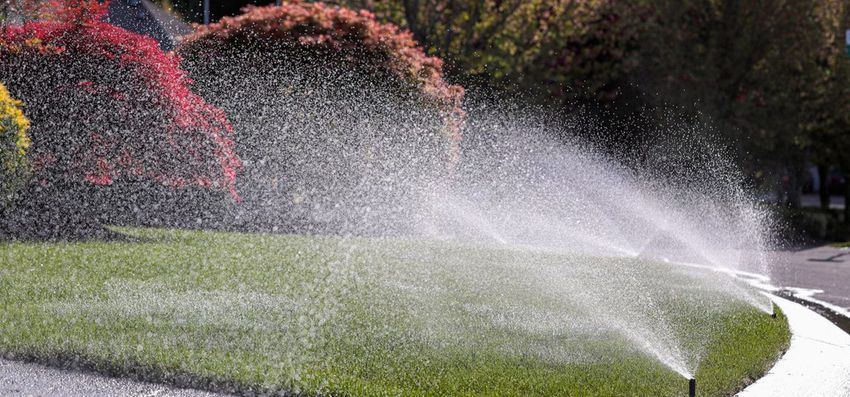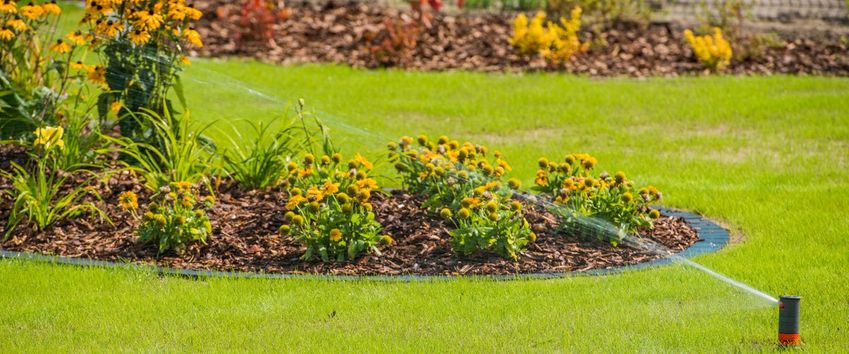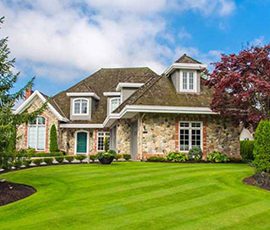
Irrigation systems are an essential part of gardens, trees and lawns in order for them to grow strong and healthy. Choosing which system is best for your needs is a crucial part of the process; making sure the system achieves all that you require will be beneficial to the growth of your lawn, garden or whatever greenery you may have. Below we will discuss the differences, pros and cons and the benefits between a drip irrigation system and a sprinkler system.
Drip Systems
Drip irrigation systems are generally found within nurseries and farms, it’s a very efficient and cost-effective option for owners to choose, especially if they have a large plot of land, garden or plants that need watering constantly without additional manual labour.
With less evaporation and the reduced waste of water from spraying all over the place, this system is around 90% more successful than others. If you are someone that is trying to grow their own vegetable garden or has small trees around your property, then a drip system would be more beneficial to your garden as it targets the root zone with its slow water application.
Trickle (drip) irrigation is a great way to save water while still watering your greenery. With the elimination of over-spraying, it cuts down on wasted water and ensures you save some money. This system works well in almost any kind of landscape. The design of the system ensures that it can access plant roots through sandy as well as clay-based soils.
Pros:
This system definitely has a lot of pros to think of when considering an irrigation system, some of the pros include:
1. Saving Money with Less Water Waste:
With the Drip irrigation system, because of the way that it functions it costs less water and money to have and use. With the limited and direct amount of water hitting your plants roots you save having to waste water being sprayed all over your vegetation. While you’re saving water you’re also saving your fertilizer from being over hydrated or flooding out from too much water.
2. Helps to Prevent Against Disease
Drip irrigation is great for preventing and eliminating disease from your plants. It does this by not having as much, if any water touching the main components of the plant. By not having water touch the main parts it helps to reduce the chances of disease growing and killing the plant. Using the Drip system also helps to limit the amount of weeds by keeping the rows between them dry.
When having too much water between the rows it can not only cause more weeds to grow but can also suffocate the roots of the plants as well. With the Drip systems direct distribution of water it is less likely for either of those situations to occur.
3. Great for Farming
Farmers or people who grow their own food find that the Drip System works the best because it does not need to have even ground in order to reach the plant roots. Drip systems can be installed across any kind of terrain including slopes.
With the Drip system it also helps to lessen the labor of watering and also is especially functional in tough conditions. Some of the conditions are clay soil which is tough for other irrigation systems to get through whereas the Drip system can still penetrate the roots through it.

Cons:
With pros there are also cons to everything, the drip system does have a few that are listed below:
1. Maintenance
The Drip system does have some downfalls such as the maintenance required in order for it to continue running smoothly. With constant exposure to the sun, foot traffic, animals and more the system can be severely worn down and even need to be replaced from damages. When the filtering system is put in it can also cause damages to the hardware if it is not properly installed or flushed out which can cause mass clogging throughout.
2. Installation
When having the Drip system installed you need to be highly skilled to do so. If you install the system incorrectly it can stop plant roots from growing properly or could kill the plant entirely by not allowing the roots to grow at all. If during the installation it again was not set up correctly it can also cause improper water distribution throughout your vegetation.
3. Expenses
The expenses of the Drip system are not cheap by any means. Installation, repairs and any other costs that may come with it can be very expensive by the end of it. The repairing of the tubing and filters can be some of the most expensive parts.
Sprinkler Systems
Sprinkler systems are very common for yards, gardens and even excessively large fields full of crops. This system has three different variations for owners to choose from including low, medium and high volume sprinklers. These systems save water and also shut off when it rains in order to prevent water waste. They also do a great job of making sure to reach all of your vegetation by setting up zones in order to cover all areas.
When putting your sprinklers in, it’s important to choose the right head in order to get the proper spray and reach you will need. When selecting zones, having the proper head will help to make sure there are no sections missed when it comes time for watering.
Sprinkler systems have an amazing feature that helps any owner from having to worry over watering their lawns ever again: timers. Sprinkler systems can be set up on timers and sensors so that your yard, garden or whatever you may have can be watered all on its own without worry or needing to do it yourself. You can also choose if you would like your sprinkler heads to sit above ground or have them emerge from the ground only when it’s time for the system to run.
On top of all of this, you can also have your sprinkler heads follow a set pattern; go back and forth or side to side and or have it run full circles. These options all depend on what kind of coverage you’re looking for, what type of vegetation you have and how your landscape is set, whether it’s slanted or flat etc.
Pros:
Some of the pros of the sprinkler system were discussed above but there are plenty more to know when choosing your system, below is a list of the pros to expect when purchasing a sprinkler system.
1. Convenience
A Sprinkler system is very convenient to have if you are someone that travels or just doesn’t have the time to water their lawn. Adding a Sprinkler system can allow you to leave for long periods of time without worry of your vegetation drying out. This system can have timers and sensors put into water exactly when you want and exactly how much your plants need. The best part is that Sprinkler systems are incredibly easy to operate.
2. Home Values Can be Increased
If you have a Sprinkler system it can help to increase your home’s overall value as it is a great selling point. On top of being a value booster, Sprinklers also help lessen your land loss by ensuring that it is cared for with the proper amount of water. This is also beneficial as good lawns or gardens help to sell a home as well.
3. Water Loss is Fairly Minimal
With a targeted Sprinkler system it can help to prevent weeds and disease within your vegetation by having a more direct contact with their roots or flower beds. This system does work really well for almost all types of fields and landscapes but is most commonly seen among peoples lawns and gardens.

Cons:
Again with all the great features there are also cons that come with it, below is a list of the disadvantages that come with having a sprinkler irrigation system.
1. Water Waste
There is some water waste to be mindful of when investing in a Sprinkler system. Wasting of water can come from the evaporation from the spraying feature and also from high winds as it blows the water away from the vegetation. This system also does not work well on slopes as it can miss the main section of plants you may want it to reach.
2. Efficiency
Sprinkler systems do fall short when it comes to sandy and clay based soils as it cannot penetrate these solids to reach the root properly. The water running through the system must always be clean and clear in order to function properly and avoid blockages. Fruits and crops can be damaged by the excess amount of water the Sprinkler system gives.
3. Cost
With a more powerful system it does need a higher and uninterrupted power supply which can be expensive. Installation can also be very cost heavy as well as the water bills over time can be higher than expected.
Lastly, each system has great benefits as well as disadvantages. Picking the proper system for your home or land is all dependent on your soils, what kind of gardens or vegetation you may have and which suits your needs. For example, sprinklers don’t work as well for sandy or clay-based soils whereas a drip system does. The drip system can suffer more damages to the tubing and different parts compared to the sprinklers, which are less likely to be damaged by the sun or people.
Using these pros and cons lists with the information above will hopefully help you to decide which system is best for you and your needs.


